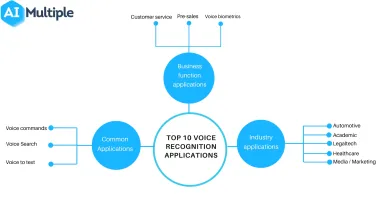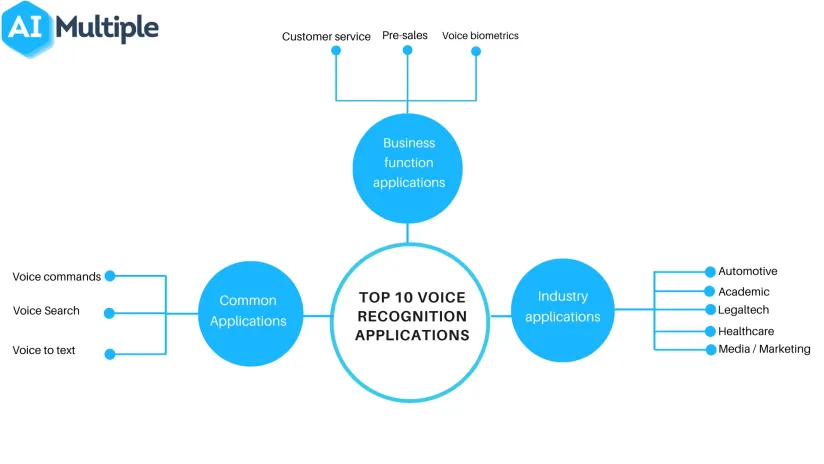Top 11 Voice Recognition Applications in 2024


If you’ve used virtual assistants like Alexa, Cortana, Google Assistant, or Siri, you might be familiar with speech/voice recognition and conversational AI concepts. Speech recognition is the technology that enables users to explain themselves verbally to a device. It does that by converting the users’ verbal queries into machine-readable text.
As voice recognition technology might be used more than simply playing your favorite song on Spotify, its top 11 uses in marketing, customer service, healthcare, and other areas are reviewed in this article.
If you are interested in working with a voice/speech data collection service, click here.
Common applications
1. Voice search
Voice search is, arguably, the most common use of voice recognition. Reportedly, in 2022, in the US alone, 135.6M users would have used a digital assistant at least once a month.
Moreover, according to a PWC survey, using a voice assistant to search for something was the preferred method of 71% of participants (Figure 1).
Source: PWC
Figure 1. 71% of the respondents preferred using their voice, rather than typing, to search for something online.
2. Speech to text
Voice recognition enables hands-free computing. Its use cases include, but are not limited to:
- Writing emails
- Composing a document on Google Docs
- Automatic closed captioning with speech recognition (i.e., YouTube)
- Automatic translation
- Sending texts ( Figure 2)
Source: PWC
Figure 2. 58% of respondents claimed to text their friends using voice assistant rather than physically typing.
3. Voice commands to smart home devices
Smart home devices use voice recognition technology to carry out household tasks, such as turning on the lights, boiling water, adjusting the thermostat, and more.
Some statistics of smart home devices are:
- By 2025, the revenue of the market for smart home devices is projected to reach $182M.
- 30% of voice assistant users state smart home devices as their primary reason(s) for investing in an Amazon Echo or Google Home.
- By 2025, 478M households will have a smart home device.
For more in-depth knowledge on data collection, feel free to download our whitepaper:
Business function applications
4. Customer service
Voice recognition is an important AI application in customer service. Voice recognition is an effective call center service solution, available 24/7, and is cheaper than live reps.
The common use cases of speech recognition in customer service are:
- Interactive Voice Response (IVR): It is one of the oldest speech recognition applications and allows customers to reach the right agents or resolve their problems via voice commands.
- Analytics: Transcription of thousands of phone calls between customers and agents helps identify common call patterns and issues.
5. Pre-sales
Sales Development Reps (SDRs) calls can be wasteful. An example would be insurance companies calling their leads and asking them questions (i.e., their age, occupation, lifestyle, etc.) to see which insurance package they’d qualify for.
Such processes could be automated with voice bots. The benefit is that the caller will not have to wait to be connected with a sales rep. Rather, the bot will immediately start the evaluation and qualification process.
6. Voice biometrics for security
Similar to how your smartphone allows you to unlock it with your fingerprints, vocal biometrics uses a person’s speech to authenticate them. Users might be required to say their name aloud during log-ins rather than typing a password.
Alternatively, speech biometrics can be used in Fintech to authorize transactions and to guarantee they are genuine and consented from the account owner. Besides, speech biometrics can restrict access to authorized personnel in healthcare, where maintaining patient confidentiality is of utmost importance.
Industry applications
7. Automotive
In-car speech recognition systems have become a standard feature for most modern vehicles. Research has shown that by 2022, 73% of drivers will use an in-car voice assistant.
The biggest benefit of car speech recognition is that it allows the driver to keep their eyes on the road and hands on the wheels. Use cases include initiating phone calls, selecting radio stations, setting up directions, or playing music.
8. Academic
80% of sighted children’s learning is through vision, and their primary motivator is to explore the environment around them. Speech recognition can create an equitable learning platform for children with no/low sight.
Language learning tools such as Duolingo use speech recognition to evaluate users’ language pronunciation. Pronunciation evaluation is a practical computer-aided language learning application.
9. Media/marketing
Speech recognition tools, such as dictation software, can enable people to write more words in less time. A study conducted by doctors using dictation software (Figure 3) showed that it produced 150 words per minute on average.
Source: Nuance
Figure 3. Doctors could write 150 words a minute using a dictation tool.
So, approximately, content creators writing articles, speeches, books, memos, or emails can transcribe 3000-4000 words in 30 minutes using these applications.
These tools aren’t 100% accurate, but they are good for first drafts.
10. Healthcare
MD note-taking
During patient examinations, doctors shouldn’t worry about taking notes of patients’ symptoms. Medical transcription (MD) software uses speech recognition to capture patient diagnosis notes.
It’s been claimed that taking notes is one of the most time-consuming activities for physicians, taking their time away from seeing patients. Thanks to MD technology, doctors can shorten the average appointment duration and, in return, fit more patients into their schedules.
Diagnosis
Depression speech recognition technology listens to a patient’s voice to identify the existence, or lack thereof, of depression undertones through words such as “unhappy,” “overwhelmed,” “bored,” “feeling void,” etc.
Vendors, such as Sonde Health, have created mobile applications that give users a score of “mental fitness” based on their voice’s tone, use of words, energy, fluctuations, and rhythm, among other variables.
11. Legal tech
Legal chatbots have grown in popularity because of their ease of use and wide applicability. Speech-enabled legal tech can expand the use cases to
- Court reporting (Realtime Speech Writing)
- eDiscovery (Legal discovery)
- Automated transcripts in depositions and interrogations
- Using NLP to review legal documents to determine if they meet regulatory criteria.
You can also check our article to learn about speech recognition challenges and solutions.
For more on conversational AI
If you are interested in learning more about conversational AI, read:
- Speech Recognition: Everything You Need to Know
- Conversational User Interfaces
- 80+ Statistics on Conversational AI
And if you are looking for a voice bot platform, feel free to check our transparent vendor lists where sorting vendors by AIMultiple score shows the best solutions based on maturity, popularity, and satisfaction.
We will help you choose the right vendor for your business:

Cem has been the principal analyst at AIMultiple since 2017. AIMultiple informs hundreds of thousands of businesses (as per similarWeb) including 60% of Fortune 500 every month.
Cem's work has been cited by leading global publications including Business Insider, Forbes, Washington Post, global firms like Deloitte, HPE, NGOs like World Economic Forum and supranational organizations like European Commission. You can see more reputable companies and media that referenced AIMultiple.
Throughout his career, Cem served as a tech consultant, tech buyer and tech entrepreneur. He advised businesses on their enterprise software, automation, cloud, AI / ML and other technology related decisions at McKinsey & Company and Altman Solon for more than a decade. He also published a McKinsey report on digitalization.
He led technology strategy and procurement of a telco while reporting to the CEO. He has also led commercial growth of deep tech company Hypatos that reached a 7 digit annual recurring revenue and a 9 digit valuation from 0 within 2 years. Cem's work in Hypatos was covered by leading technology publications like TechCrunch and Business Insider.
Cem regularly speaks at international technology conferences. He graduated from Bogazici University as a computer engineer and holds an MBA from Columbia Business School.
To stay up-to-date on B2B tech & accelerate your enterprise:
Follow onNext to Read
Speech Recognition: Everything You Need to Know in 2024
Top 5 Speech Recognition Data Collection Methods in 2024
4 Ways to Overcome Deep Learning Challenges in 2024
Voice recognition tools are really helpful! As an alternative, I can recommend Audext. It works quite fast, and it has many useful features such as an in-built editor, text timings tracking, voice recognition in noise, etc.
Comments
Your email address will not be published. All fields are required.